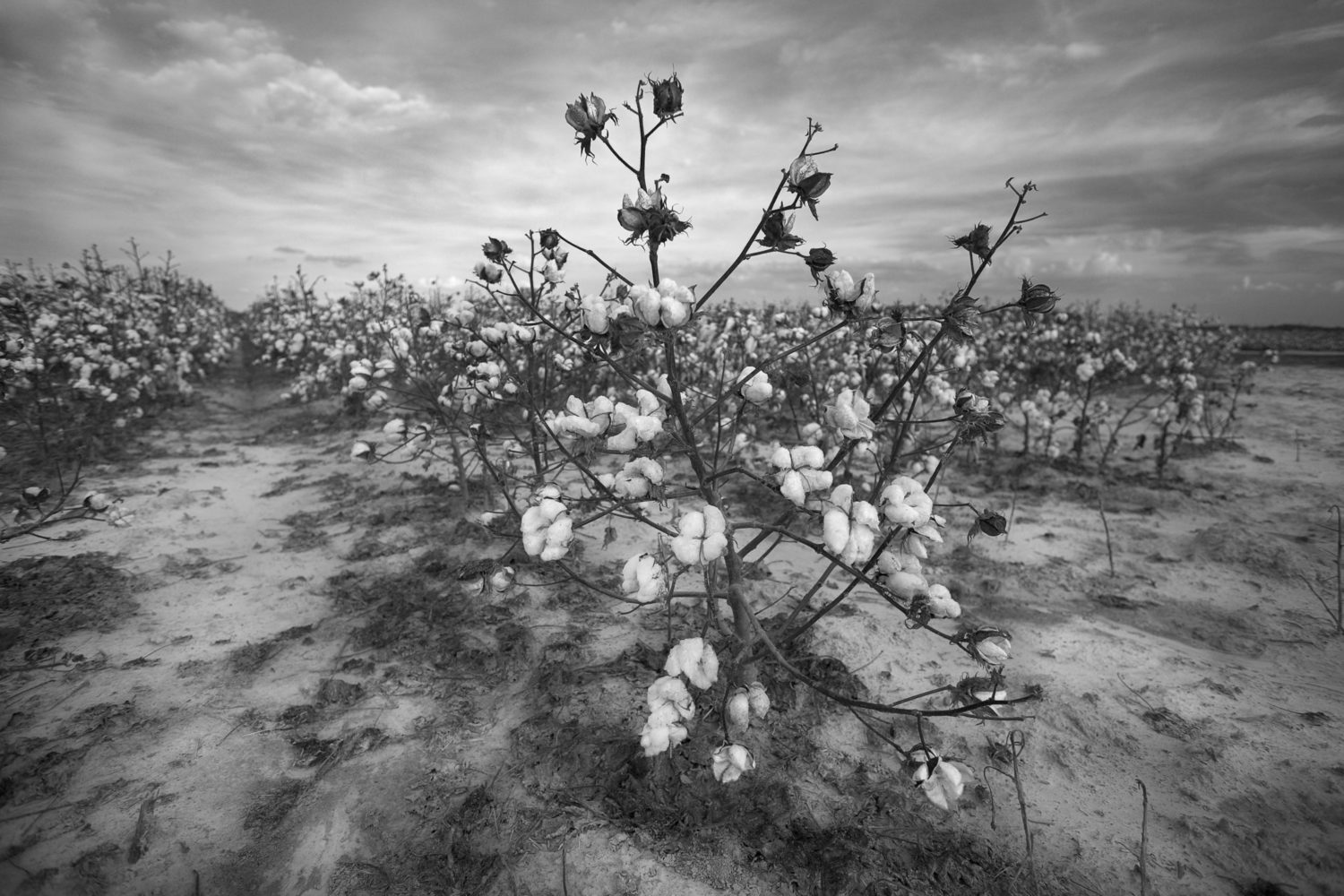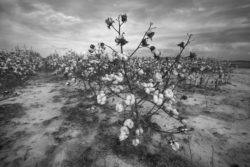Jennifer Ellerbe
Jennifer Ellerbe is a photographer and artist who has found her visual poetry in the dark bayous and shadows along the back roads and endlessly flat landscape of Louisiana.

Courtesy of Jenny Ellerbe.
Monroe photographer Jenny Ellerbe creates visual poetry from the mundane scenes in rural Ouachita Parish, as in this carbon inkjet print, "Cotton, Study 1, Ouachita Parish, 2006."
Jennifer K. Ellerbe, born March 16, 1960, in Monroe, Louisiana, is a photographer and artist who has found her visual poetry in the dark bayous and shadows along the back roads and endlessly flat landscape of Ouachita, Union, East and West Carroll, Morehouse, and Richland parishes, Northeast Louisiana’s Delta country. Her photographs tell of a personal journey that found expression not in distant places but of self-discovery in a familiar landscape and among people known all along.
“The small corner of northeastern Louisiana [from Monroe east to the Mississippi River, and north to the Arkansas state line] is too far north of New Orleans to be of much interest to anyone who doesn’t live there,” she once said in an artist statement, describing her native land. “It is a region of contrasts—elegant bayous that flow past decaying towns, rich farmland surrounded by abject poverty. It is a place that nurtured me through childhood, confined me as a young adult and called me home every time I moved away. It is a place where I have lived most of my life but that I have never fully understood. And it is that misunderstanding that has inspired me to explore what is so familiar on the surface and such a mystery underneath.”
Here is Home is the title of Ellerbe’s 2008 book—an oversize collection of forty-five black-and-white images that range from cotton fields in Ouachita Parish to a stand of sunflowers in Richland Parish. Her straightforward imagery evokes the works of Russell Lee, Walker Evans, and other great documentary photographers who roamed the nation’s rural back roads during the Great Depression to capture a suffering America. Other photos are like faded childhood memories of an earlier time in rural Louisiana when life was simple but hard. Ellerbe describes her work as “quiet, straightforward but layered.”
In the foreword to Here Is Home, Ellerbe writes, “The photographs in this book all began as personal journeys for me. I needed to know how it felt to stand in the early morning mist surrounding a boggy marsh. And to paddle a small kayak through a bayou shrouded in deep fog. And to drink a cold bottle of Coke in a rundown store on a deserted two-lane in the middle of farmland. Mostly, I needed to know how I felt in all those places, how they affected me, and how they fit together into the life of a southern girl who always wanted to be somewhere else.”
Ellerbe feels a spiritual connection to the Delta. She talks about the land formed by centuries of alluvial sediment from the Mississippi River, of the ancient mound builders of Poverty Point, and the people who have farmed and worked the Delta for generations. “I feel those people, their spirit,” she says. “My great grandmother lived in Union Parish. When I was a kid, she had a vegetable garden. We all ate from that garden. I remember her out there shelling butter beans and the connection to the land, and my grandfather’s connection to the land. Maybe I miss that and I find it somehow when I’m out there.”
Ellerbe’s early professional background was not in photography but in medicine. For more than twenty years, she was a pediatric nurse. Nursing gave her the ability to fulfill childhood dreams of being “somewhere else.” For a time she lived and worked in St. Petersburg, Florida, then Dallas, Texas, and finally in New Haven, Connecticut, where she worked at the Yale-New Haven University Hospital. New Haven was a short train trip away from Manhattan. “I always wanted to live in New England and be able to take a train to New York,” she says. “I thought that would be wonderful. Then we had the worst winter in a hundred years and I sat in snow and started thinking about the bayou, moss and trees.”
While working at Yale University, she took a writing course, thinking she might like to pursue a writing career. For a class assignment, she wrote an article about the bayous and added a few photographs from back home to illustrate the story. That’s when she realized how much she missed the Louisiana Delta. “I was ignoring all the signals,” she says. She packed up, quit her job, and returned to Louisiana. That was 1997. Back home, she worked for a while at a hospital in West Monroe, then left in 2001 to pursue her growing passion for photography.
In 2007 her career took another major turn. She was invited to teach printmaking at the Ansel Adams Workshop at Mono Lake south of Lake Tahoe, Nevada. She went back again in 2008 and in 2009 taught at Ansel Adams’s famed studio in Yosemite National Park in California.
A self-taught photographer, Ellerbe has shown her work in galleries in New Orleans; Dallas, Texas; Boston, Massachusetts; Tampa, Florida; Baltimore and Annapolis, Maryland; Carmel, California; and Seattle, Washington. In addition to private collections, her photographs can be found in the permanent collections of the Museum of Fine Arts in Houston, Texas, and the Masur Museum of Art in Monroe, Louisiana. In 2007, Photolucida, an international nonprofit photography organization, named Ellerbe to its Critical Mass Top 50 list of photographers. Two years later, the organization named her a finalist in that competition. That same year, she received a Louisiana Cultural Economy grant and was named a finalist for a Michael P. Smith Documentary Photography grant.
